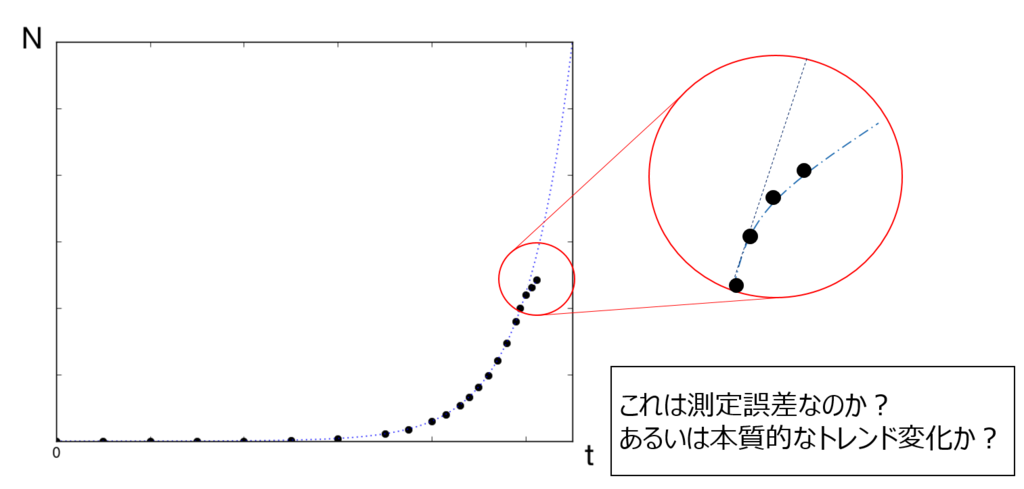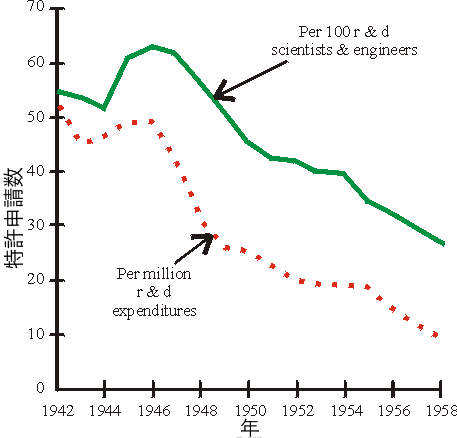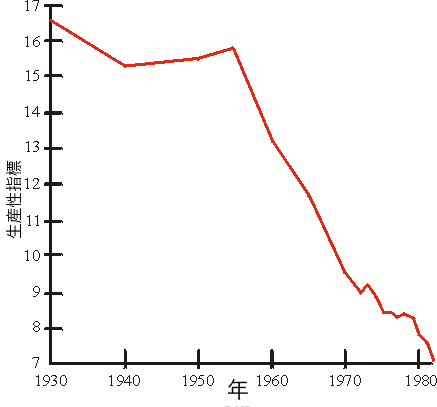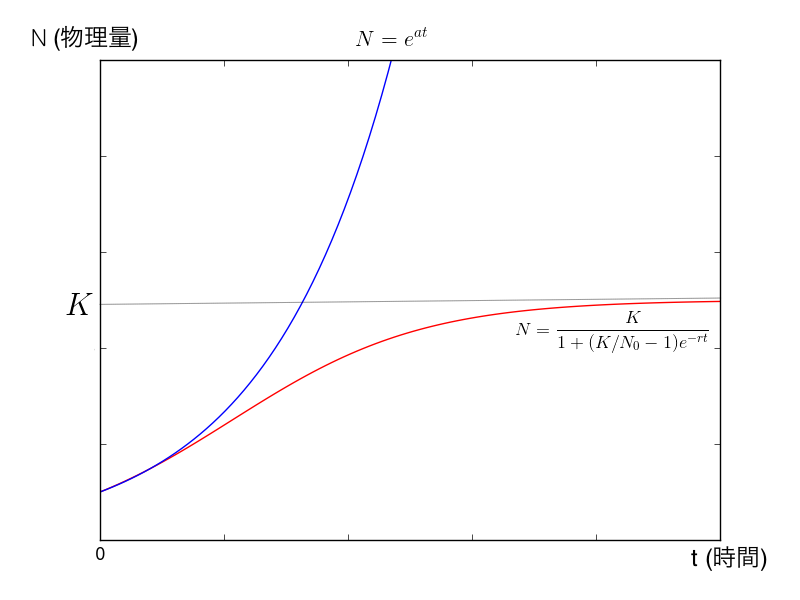
- Ander Korotayev、Artemy Malkov、Daria Khaltourina「社会のマイクロダイナミクス:世界システムの成長とコンパクト・マクロモデル」『情報社会学会誌』第2巻第1号、2007年。
収穫加速の法則と技術的特異点の到来編集
| 「 | 秩序が指数関数的に成長すると、時間は指数関数的に速くなる — つまり、新たに大きな出来事が起きるまでの時間間隔は、時間の経過とともに短くなる。 | 」 |
というものである。
また収穫加速の法則は、生命進化のプロセスにも適用されており、DNAの成立、生殖という発明、発明を作る発明としての人間の誕生などを一元的に捉え、ムーアの法則によって示されたような秩序を増大させる技術革新はトランジスタ製造技術の枠を超えて継続するという主張を展開した。
前項で述べた、「収穫加速の法則」においてパラダイムが定義されていないという問題も無視しがたいものですが、けれども、実際のところ、歴史的な事象の発生頻度が指数的な分布を示していることは、ある意味では真実です。そのため、宇宙、生命、人類の歴史とテクノロジーを一つの対数グラフ上にまとめて掲載してしまえば、成長曲線が今後進んでいく方向が、誤差として完全に覆い隠されてしまいます。
よって、注目するべきは、直近の過去において成長曲線がどこへ向かっているかです。

図1: 指数関数の進む方向
そして、私が「収穫加速の法則」とその帰結であるシンギュラリティに対して懐疑的になったそもそもの理由は、「収穫加速の法則」から予想される加速度的な変化が、過去20年ばかりの私の生活実感において全く感じられないことにあります。
と言うよりも、さまざまな現象を虚心坦懐に取り上げてみれば、指数関数的な成長ではなく、むしろ減速、停滞が、あらゆるところで観察できます。
カーツワイル氏は、「収穫加速の法則」を根拠として、20世紀の100年間全体で起きた「パラダイム・シフト」と同等のものが、2000年から2014年までの14年間に発生する、と2005年に予測していました。2017年現在では更に「20世紀全体と同等のパラダイム・シフト」が起こるまでの期間は短くなっているはずです。
わたしのモデルを見れば、パラダイム・シフトが起こる率が10年ごとに2倍になっていることがわかる。(中略) 20世紀の100年に達成されたことは、西暦2000年の進歩率に換算すると20年で達成されたことに相当する。この先、この西暦2000年の進歩率による20年分の進歩をたったの14年でなしとげ(2014年までに)、その次の20年分の進歩をほんの7年でやってのけることになる。別の言い方をすれば、21世紀では、100年分のテクノロジーの進歩を経験するのではなく、およそ2万年分の進歩をとげるのだ(これも今日の進歩率で計算する)。もしくは、20世紀で達成された分の1000倍の発展をとげるとも言える。*1
この時間間隔は、私が恣意的に設定したものではなく、カーツワイル氏自身が主張している時間間隔です。
やはりここでもカーツワイル氏は「達成された進歩の総量」が一体何を表すのかを定義しておらず、定量的な議論は不可能です。けれども、私自身の生活実感と社会の変化を考えても、科学的発見や技術革新を考えても、あるいはそれ以外のいかなる意味においても、20世紀の1世紀全体と2000年からの14年間では、前者における進歩が大きいと考えます。
生活水準の比較

図2: 1920年代の日本の風景
まずは、人々の生活水準の観点から20世紀の100年間と、21世紀最初の16年間を比較してみます (近年の進歩をやや保守的に捉えます)。
1900年の日本人は、現在の私たちが「健康で文化的な最低限度の生活」と考える水準を下回る生活を送っていました。
近代的な上下水道、電気、電話などは19世紀末ごろに商用化が始まり、20世紀後半の高度成長期にようやく日本全国へと普及しました。移動手段としての馬匹は、実は戦後まで利用されており、自家用車の世帯普及率は1960年代でも10%を下回っていました。1900年代の日本人は9割以上が農業に従事しており、平均寿命は40歳程度でした。その後、1999年の平均寿命は81歳と、40年以上増加しています *2。
現在の私たちの生活を物質面で定めるもの、水道、電気、電話、自動車などは、ほぼ全てが19世紀に始まり、20世紀後半に普及したものです。
また、日本における商用インターネットの開始は1990年代であり、一般家庭への普及のきっかけとなったのは1995年のWindows95発売ですから、インターネットの発明と実用化も20世紀の出来事に含むことができるでしょう。
1900年と2000年の生活の違いを考えると、物質的な側面においては2000年と2016年の違いはそれほど大きくないように感じます。
もちろん、2000年にはスマートフォンは存在せず、携帯電話の普及率はようやく50%を超えた程度でした。フェイスブックやツイッターなど、名だたる有名IT企業もまだ存在していませんでした。
けれども、1900年と2000年の間にある相違と比較すれば、2000年と2016年はほぼ同じ種類の社会であると言えます。そこで、ある二人のタイムトラベラーを想像してみてください。
二人のタイムトラベラー
一人は1880年の生まれで1900年に20歳を迎えた青年であり、その後タイムマシンでいきなり2000年に連れて来られてしまったのです。
おそらく彼は、生活と労働のあらゆる側面で非常な困難を覚えるだろうことは疑いの余地がありません。電話やテレビは魔術であり、馬も無しに高速で進む鉄の馬車に怯え、家業の農業を続けるにしても化学肥料やトラクターやらの使い方は分からず、お金を稼ぐどころか銀行の使い方ですら学ぶことは難しいかもしれません。
そもそも、共通日本語が日本全国でおおむね普及したのは戦後のテレビの普及後であり、もしも彼が九州や東北の出身であった場合、現代では会話すら不可能である可能性もあります。
もう一人は、1980年に生まれ高卒で就職し、2000年に成人していた青年です。彼もまた、2000年から現在の2017年に連れられてきたタイムトラベラーなのです。
彼は、テレビ、冷蔵庫、洗濯機や炊飯器など大体の家電を使うことができ、自分のPCや携帯電話は持っていなかったかもしれませんがどういうものかは知っており、おそらくPCで事務仕事をすることも、スマートフォンを使ってSNSに自撮りを投稿することもすぐに学べるだろうと思います。運転免許は失効しているでしょうが、車の構造は変わっていないので、運転技能それ自体に問題はないでしょう。
近年の世情を知らないことから来る混乱はあるかもしれませんが、仕事と住居を探して、必要な商品を購入し、友人や恋人を見つけ、その後生きていくことにさほどの難しさはないだろうと思います。
数年後には、自分から申告しなければ、彼が2000年からのタイムトラベラーであることは誰からも気付かれないかもしれません。
この二人の架空のタイムトラベラーがその後辿るであろう人生を考えてみると、20世紀全体の100年間と、2000年からの16年間では、確実に前者の進歩が質・量の両面でより大きいと断言できます。
日本において、生活水準の指数関数的な成長が発生したのは20世紀です。そして、生活水準の指数関数的な成長は既に高度成長期には停滞を迎えています。
もちろん、将来予測としては、今後何らかのブレイクスルーが発生し、核融合や高効率のソーラー発電が実用化されることで無尽蔵のエネルギーが供給され、寿命がいきなり何百年も延長される可能性はあります。
けれども、カーツワイル氏の「収穫加速の法則」の言葉を素直に読めば、新たな発明が他の発明と組み合わされ発明の頻度が増加し連続的に継続され、継続的な「パラダイム・シフト」が続き、ますます高密度に加速していくはずであり、全体としては停滞を挟む不連続で劇的なジャンプは想定されていません。(なお、私が本節で検証しているのは、過去実際に発生した事象に対して「収穫加速の法則」を適用することであり、法則から得られる将来予測は対象としていないことに注意してください。)
生活水準について言えば、「収穫加速の法則」は過去を説明することに失敗しています。
科学技術に関する比較
次はもう少し真面目に、科学的な発見および工学的なテクノロジーの発明について検討してみます。世界全体の科学的発見と発明は、一様に指数関数的に加速して進歩しているわけではなく、実際のところ、減速ないしは停滞していると主張する研究が存在しています。
- 作者: タイラー・コーエン,若田部昌澄,池村千秋
- 出版社/メーカー: エヌティティ出版
- 発売日: 2011/09/22
- メディア: 単行本
- 購入: 13人 クリック: 670回
- この商品を含むブログ (43件) を見る
たとえば、アメリカの経済学者タイラー・コーエンは著書『大停滞』の中で、1955年前後から情報技術以外の分野におけるイノベーションの生産性が低下したことが、先進国の経済的成長率の鈍化の原因である可能性を示しています。
コーエンによれば、「人口当たりのイノベーション件数は1873年を境に減少に転じている。これは、電気と自動車の時代への移行が始まった時期とほぼ一致する *3」とされています。イノベーションが最も活発だった時代は、実は情報テクノロジーの発展前であったと言うのです。
また、アメリカの歴史家ジョセフ・テインターによる『複雑な社会の崩壊 (The Collapse of Complex Societies)』(邦訳未刊)では、研究ヘの資金投入に対する特許申請数、および合衆国の保健システムの生産性が、定常的に低下していることが示されています*4。

図3: 研究への資金投入に対する特許申請数

図:4 米国の保健システムの生産性 (生産性指標 = (寿命)/(GNPに占める保健支出)により産出)*5
この期間内には、ムーアの法則が完全に機能しており、情報テクノロジーが指数関数的な成長を遂げていました。けれども、情報テクノロジーの発展は、他分野のテクノロジーの発展に結びついていないと言うことができるでしょう。
更に、研究成果の内容を詳細に検討します。20世紀には、基礎科学と応用科学、技術において、真に「パラダイム・シフト」と呼べるような革新的な新発見と発明が多数存在しました。
トムソンが電子を発見した1897年以来、量子力学、核物理学は20世紀に長足の進歩を遂げ、原子爆弾や原子力発電所も実用化されました。
天文物理学と宇宙論について言えば、特殊相対性理論は1905年に発表されています。1920年代にはハッブルが宇宙は膨張していることを発見し、20世紀後半にはその理論的な説明として、ビッグバン理論が科学者の間でも受け入れられました。意外なことに、「宇宙に始まりがある」という考え方は、あまりに宗教じみているとして、多くの科学者は最初拒否感を示したと言われています。
化学では、高分子化学が発達しプラスチックやナイロンなどが開発され、ペニシリンなどの抗生物質の製薬も開始されました。有史以来、人間の死因リストの最上位に位置していたのは感染症であり、それに対抗する抗生物質の発明こそが人間の健康と幸福に対する最大の貢献者です。
また、生物学では分子生物学が進化を遂げ、DNA二重らせん構造の発見があり、近代的な遺伝子学も始まりました。
そして、半導体トランジスタの発明も挙げられます。1947〜1948年に相次いでトランジスタが開発され、その後現在まで続く半導体産業の幕開けとなりました。
飛行機、ロケット、人工衛星など、空と宇宙を利用する技術の開発も進みました。
ひるがえって、2000年以降現在の2017年までの科学的な進歩を考えてみます。
クローン羊の誕生(2000年)、ヒトゲノム計画の完了(2003年)、iPS細胞の発見(2006年)、ヒッグス粒子の発見(2008年)、ディープラーニング(2006年〜) などが挙げられるでしょうが、科学的な原理における大発見は少ないように見えます。
というよりも、量的には、2000年から2014年までの間において「パラダイム・シフト」と呼べるほどの巨大な発見は決して多くありません。
もちろん、私は21世紀に入ってからは科学が停滞している、と言うつもりはありません。近年でも論文出版数は増加し続けています。けれども、カーツワイル氏が主張するように「20世紀全体と同量の進歩が起きるスピードが加速している」とはとても言えません。
次に、質的な意味で科学的発見を検討します。科学的な発見の意義を比較することは困難ですが、20世紀における相対性理論、原子物理学、ビッグバン理論、あるいは不確定性原理や不完全性定理のように、私たちの世界観・人間観・宇宙観全てを根本から変えるほどの巨大で原理的な発見は21世紀には存在しておらず、どちらかと言えば微小で応用的な分野における発見が続いているように見えます。
思想家である内山節は、著書『日本人はなぜキツネにだまされなくなったのか』において、豊かな自然と動物との交流に彩られた日本人の世界観が、近代的な科学教育とメディアの影響によって、1965年ごろを境として劇的に変化したことを記しています。それに先立って19世紀ごろから、欧米・中東の一神教文明世界においても、中世から続くネオプラトニズム的世界観は科学的機械論的な世界観の影響により、修正を迫られました。そのような大規模かつ根本的な世界観・人間観の変化は、21世紀の科学からは発生していません。
21世紀の科学的発見や、近年に発達した技術についても、原理自体は20世紀に発見されているものも少なくありません。
たとえば、量子コンピュータの原理が発明されたのは1980〜90年代であり、またブレインマシンインターフェイス (BMI) についても、基礎となる非侵襲的な脳モニタリングは、1990年代には既に実用化されています。ヒトゲノム計画、動物クローン技術も、計画自体は前世紀から開始されていました。ヒッグス粒子の理論的予測は1960年代に遡ります。そして、ディープラーニングに至っては、原理であるニューラルネット自体は1950年代に既に開発されています。
おそらく、真に21世紀に発生した科学的な「パラダイム・シフト」と間違いなく呼べるものは、「幹細胞の発見と再生医学」だけなのではないかと思います。この分野は、近年のSTAP細胞に関する騒動を見ても分かる通り、まだトーマス・クーンのパラダイム論における「変則事例 (アノマリー)」の発見と「異常科学」の状態が続いています。
つまり、科学者たちが既存の理論に当てはまらない新たな現象を発見し、次の新たなパラダイムを探している段階です。
もちろん、私は2000年以降になされた科学的な発見を軽視するつもりはありません。今後、これまで報道されていない科学研究が脚光を浴びることもあるでしょう。もちろん言うまでもなく、前世紀からずっとコンピュータ技術の進歩は続いています。おそらく、機械学習に限って言えば、21世紀には既に20世紀よりも大きな進歩を遂げたと言えます。
けれども、「収穫加速の法則」とカーツワイルの言葉を素直に受け止めれば、コンピュータや機械学習ごときの、単独のテクノロジーの成長を対象としているわけではありません。宇宙と生命とテクノロジーの進歩、その全てを視野に捉えた壮大な指数関数的な歩みが存在していなければおかしいはずです。
けれども、カーツワイル氏が言う「進歩の総量」をいかなる意味で捉えるにせよ、パンフォーカスの広い視野の中で20世紀と21世紀を捉えてみると、21世紀最初の16年間には20世紀全体の100年間と同等の変化、同等の進歩、同量の科学的発見は発生していません。
まとめ
以上のことから、過去、実際に起きた歴史的事象を対象とすると、「収穫加速の法則」は過去発生した現象を説明できず、モデルとしての妥当性を欠いています。過去の事象を説明できないモデルは、当然のことながら未来の予測に対しても不適切です。
実際のところ、「収穫加速」どころか、21世紀には20世紀と比べて情報テクノロジーの発展以外は減速している、と主張することさえ可能であり、それを裏付けるデータも存在しています。このように、最初急速に指数関数的な成長を遂げ、次第に成長が穏やかになる現象を、よく説明し予測できるモデルがあります。

図5: S字曲線
The Law of Accelerating Returns (English: The Law of Accelerating Returns) was advocated by American inventor Ray Kurzweil, and one important invention was linked to another, and the next important invention. It is an empirical rule that science and technology advance exponentially rather than linearly by shortening the time to the emergence of a new invention and accelerating the speed of innovation. It is also the title of an essay he mentioned about this law. It is advocated as a concept to contrast with traditional diminishing returns or limited increasing returns.
Ander Korotayev, Artemy Malkov, Daria Khaltourina “Microdynamics of Society: Growth of World Systems and Compact Macromodels”, Journal of Information Sociology, Vol. 2, No. 1, 2007.
Accelerating change law and the arrival of the technological singularity Edit
Kurzweil’s law of acceleration of harvest does not only cover the law of speed of technological innovation, but is a subordinate law of the general law of the relationship between order, chaos and time, which is defined as useful information in a broad sense. It is positioned as. This takes into account the law of increasing entropy, and takes into account the law of increasing order in the universe. According to Kurzweil’s definition, the law of accelerated harvest is
An important event that became a paradigm shift in human history with 15 independent lists, shown in a log-log graph. Listed include Carl Sagan, Paul D. Boyer, Encyclopaedia Britannica, American Museum of Natural History, University of Arizona and others. Edited by Ray Kurzweil.
“As order grows exponentially, time becomes exponentially faster — that is, the time interval between new major events becomes shorter over time.”
That is.
The law of accelerated harvest is also applied to the process of life evolution, and it seems that Moore’s law centrally grasps the formation of DNA, the invention of reproduction, the birth of human beings as the invention that makes the invention, etc. He argued that technological innovations that would increase the order would continue beyond the boundaries of transistor manufacturing technology.
The problem that the paradigm is not defined in the “accelerating change” mentioned in the previous section cannot be ignored, but in reality, the frequency of occurrence of historical events shows an exponential distribution. Being is, in a sense, true. Therefore, if the history and technology of space, life, and humankind are posted together on one logarithmic graph, the direction in which the growth curve will advance will be completely obscured as an error.
So what should be noted is where the growth curve is heading in the last past.
Figure 1: Direction of exponential function
And the reason why I became skeptical about the “accelerating change” and its consequent singularity is that the accelerating changes expected from the “accelerating change” have been around for the past 20 years. There is something I can’t really feel in my life.
Rather, if you take up various phenomena in a vain manner, you can observe slowdowns and stagnations everywhere, rather than exponential growth.
Kurzweil said that on the basis of the “accelerating change”, the equivalent of the “paradigm shift” that occurred throughout the 100 years of the 20th century will occur in the 14 years from 2000 to 2014, 2005. I was expecting it. As of 2017, the period until the “paradigm shift equivalent to the entire 20th century” should occur is shorter.
If you look at my model, you can see that the rate of paradigm shifts doubles every 10 years. (Omitted) What was achieved in 100 years of the 20th century is equivalent to what was achieved in 20 years when converted to the progress rate of 2000 AD. In the future, 20 years of progress based on the progress rate of 2000 AD will be achieved in only 14 years (by 2014), and the next 20 years of progress will be achieved in just 7 years. In other words, in the 21st century, instead of experiencing 100 years of technological progress, we will make about 20,000 years of progress (again, calculated at today’s rate of progress). Or it can be said that it will achieve 1000 times the development achieved in the 20th century. * 1
This time interval is not something I set arbitrarily, but Kurzweil’s own claim.
Again, Kurzweil does not define what the “total amount of progress achieved” represents, and quantitative discussion is impossible. But in the whole 1st century of the 20th century and in the 14 years since 2000, whether I think of my own feelings of life and social changes, scientific discoveries, technological innovations, or in any other sense. , I think that the progress in the former is great.
Comparison of living standards
Figure 2: Landscape of Japan in the 1920s
First, let’s compare the 100 years of the 20th century with the first 16 years of the 21st century from the perspective of people’s living standards (a somewhat conservative view of recent progress).
The Japanese in 1900 lived below what we now consider to be a “healthy and culturally minimal life.”
Modern water and sewage systems, electricity, telephones, etc. began to be commercialized around the end of the 19th century, and finally spread throughout Japan during the high-growth period of the latter half of the 20th century. Horses as a means of transportation were actually used until after the war, and the household penetration rate of private cars was less than 10% even in the 1960s. More than 90% of the Japanese in the 1900s were engaged in agriculture, and their average life expectancy was around 40 years. Since then, life expectancy in 1999 was 81 years, an increase of more than 40 years * 2.
Almost all of the things that define our lives today, such as water, electricity, telephones, and automobiles, began in the 19th century and became widespread in the latter half of the 20th century.
In addition, the commercial Internet started in Japan in the 1990s, and it was the release of Windows 95 in 1995 that triggered the spread to general households, so the invention and practical application of the Internet can be included in the events of the 20th century. Let’s do it.
Considering the difference in life between 1900 and 2000, I feel that the difference between 2000 and 2016 is not so big in terms of materiality.
Of course, in 2000, smartphones did not exist, and the penetration rate of mobile phones finally exceeded 50%. Well-known IT companies such as Facebook and Twitter didn’t exist yet.
However, when compared to the differences between 1900 and 2000, 2000 and 2016 are about the same kind of society. So imagine two time travelers.
Two time travelers
One was a young man who was born in 1880 and turned 20 in 1900, and was suddenly brought to 2000 by a time machine.
There is no doubt that he will experience great difficulties in every aspect of life and labor. Telephones and televisions are magic, scared of fast-moving iron carriages without horses, and even if you continue to farm your family, you don’t know how to use fertilizers or tractors, and even learn how to use banks instead of making money That can be difficult.
In the first place, common Japanese became popular all over Japan after the spread of television after the war, and if he was from Kyushu or Tohoku, it may not even be possible to speak in modern times.
The other is a young man who was born in 1980, got a job with a high school diploma, and was an adult in 2000. He is also a time traveler brought from 2000 to the present 2017.
He can use most appliances such as TVs, refrigerators, washing machines and rice cookers, and he may not have his own PC or cell phone, but he knows what it is, and probably offices on his PC. I think you’ll soon learn to work and post selfies on social media using your smartphone. Your driver’s license will have expired, but the structure of the car hasn’t changed, so your driving skills themselves shouldn’t be a problem.
There may be some confusion that comes from not knowing the world in recent years, but it’s not too difficult to find a job and a place to live, buy what you need, find friends and lovers, and then live. I think it will be.
A few years later, no one may notice that he is a time traveler since 2000, unless he declares himself.
Considering the life that these two fictitious time travelers will follow, in the 100 years of the entire 20th century and the 16 years from 2000, the progress of the former is definitely better in terms of both quality and quantity. I can assure you that it is big.
Exponential growth of living standards occurred in Japan in the 20th century. And the exponential growth of living standards has already stagnated during the high-growth period.
Of course, as a future forecast, there is a possibility that some kind of breakthrough will occur in the future, and the practical application of nuclear fusion and high-efficiency solar power generation will supply inexhaustible energy and suddenly extend the life span by hundreds of years. ..
However, if you read Kurzweil’s “Accelerating Change” straightforwardly, new inventions will be combined with other inventions, and the frequency of inventions will increase and continue continuously, resulting in a continuous “paradigm shift.” It should continue to accelerate more and more densely, and overall no discontinuous and dramatic jumps across the stagnation are expected. (Note that what I am verifying in this section is to apply the “accelerating change law” to the events that actually occurred in the past, and not to the future predictions obtained from the law. please.)
When it comes to living standards, the “accelerating change” fails to explain the past.
Comparison of science and technology
Next, let’s take a closer look at scientific discoveries and inventions of engineering technology. Scientific discoveries and inventions throughout the world are not uniformly exponentially accelerating and advancing, and in fact there are studies claiming that they are slowing or stagnant.
Great stagnation
Authors: Tyler Cowen, Masazumi Wakatabe, Chiaki Ikemura
Publisher / Manufacturer: NTT Publishing
Release date: 2011/09/22
Media: Book
Purchase: 13 people Click: 670 times
View blogs (43) that include this product
For example, American economist Tyler Cowen wrote in his book The Great Stagnation that the decline in innovation productivity in areas other than information technology from around 1955 caused the slowdown in economic growth in developed countries. Indicates the possibility of
According to Cohen, “The number of innovations per capita has been declining since 1873. This is almost the same as the time when the transition to the era of electricity and automobiles began * 3.” It is said that the time when innovation was most active was actually before the development of information technology.
Also, in The Collapse of Complex Societies by American historian Joseph Teinter, the number of patent applications for funding research and the productivity of the US health system are discussed. It has been shown to be steadily decreasing * 4.
Figure 3: Number of patent applications for research funding
Figure: 4 Productivity of the US health system (productivity index = (lifetime) / (produced by health expenditure in GNP)) * 5
During this period, Moore’s Law was fully functional and information technology was growing exponentially. However, it can be said that the development of information technology is not linked to the development of technology in other fields.
In addition, we will examine the content of the research results in detail. In the 20th century, there were many innovative new discoveries and inventions in basic science, applied science, and technology that could truly be called a “paradigm shift.”
Since 1897, when Thomson discovered the electron


